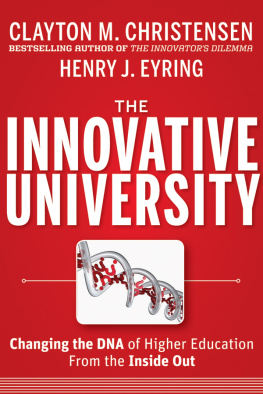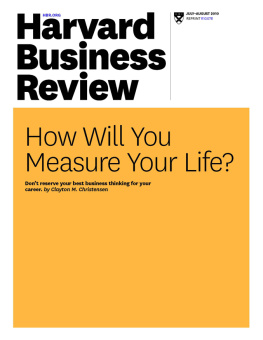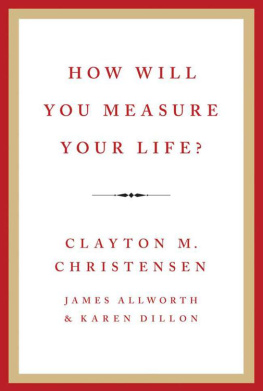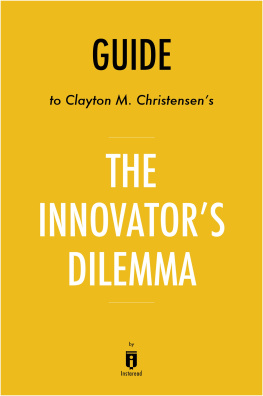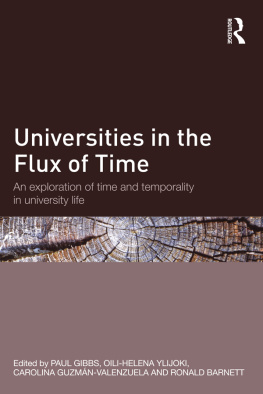Copyright 2011 by Clayton M. Christensen and Henry J. Eyring. All rights reserved.
Published by Jossey-Bass
A Wiley Imprint
989 Market Street, San Francisco, CA 94103-1741www.josseybass.com
No part of this publication may be reproduced, stored in a retrieval system, or transmitted in any form or by any means, electronic, mechanical, photocopying, recording, scanning, or otherwise, except as permitted under Section 107 or 108 of the 1976 United States Copyright Act, without either the prior written permission of the publisher, or authorization through payment of the appropriate per-copy fee to the Copyright Clearance Center, Inc., 222 Rosewood Drive, Danvers, MA 01923, 978-750-8400, fax 978-646-8600, or on the Web at www.copyright.com. Requests to the publisher for permission should be addressed to the Permissions Department, John Wiley & Sons, Inc., 111 River Street, Hoboken, NJ 07030, 201-748-6011, fax 201-748-6008, or online at www.wiley.com/go/permissions.
Excerpts from The Glass Bead Game (ISBN 978-0-312-27849-6) by Hermann Hesse used by permission of Picador.
Readers should be aware that Internet Web sites offered as citations and/or sources for further information may have changed or disappeared between the time this was written and when it is read.
Limit of Liability/Disclaimer of Warranty: While the publisher and author have used their best efforts in preparing this book, they make no representations or warranties with respect to the accuracy or completeness of the contents of this book and specifically disclaim any implied warranties of merchantability or fitness for a particular purpose. No warranty may be created or extended by sales representatives or written sales materials. The advice and strategies contained herein may not be suitable for your situation. You should consult with a professional where appropriate. Neither the publisher nor author shall be liable for any loss of profit or any other commercial damages, including but not limited to special, incidental, consequential, or other damages.
Jossey-Bass books and products are available through most bookstores. To contact Jossey-Bass directly call our Customer Care Department within the U.S. at 800-956-7739, outside the U.S. at 317-572-3986, or fax 317-572-4002.
Jossey-Bass also publishes its books in a variety of electronic formats. Some content that appears in print may not be available in electronic books.
Library of Congress Cataloging-in-Publication Data
Christensen, Clayton M.
The innovative university : changing the DNA of higher education from the inside out / Clayton M. Christensen and Henry J. Eyring.
p. cm
Includes index.
ISBN 978-1-118-06348-4 (hardback); 978-1-118-09125-8 (ebk); 978-1-118-09126-5 (ebk); 978-1-118-09127-2 (ebk)
1. Universities and collegesUnited States. 2. Educational changeUnited States. I. Eyring, Henry J. II. Title.
LA227.4.C525 2011
378.73dc22
2011015805
Preface
Because the research and writing of this book began and ended with Henry Eyring, I have written this preface so that our readers might glimpse what a privilege it has been for me to watch Henry's extraordinary mind and his selfless heart at work as we crafted this book.
In 2000, Ricks College, a two-year school in rural southern Idaho, became a four-year school, Brigham Young University (BYU)-Idaho. The creation of BYU-Idaho took almost everyone by surprise. It wasn't just that its sponsor, the Church of Jesus Christ of Latter-day Saints (more commonly known as the Mormon Church) had a policy of preventing mission creep at its four institutions of higher learning. At least as surprising as the decision to make Ricks a four-year institution was its unique design. The new university would remain focused on undergraduate instruction: there would be no graduate programs and no traditional research scholarship. One of the most successful junior college athletic programs in the United States would be eliminated.
The university would also pursue new efficiencies. It would operate year-round, and new technologies, especially online learning, would be used to serve more students at lower cost. In becoming a university, the former Ricks College would actually operate more in the spirit of a community college than it had before.
At the time of BYU-Idaho's creation, Henry J. Eyring was at a sister institution, Brigham Young University in Provo, Utah, directing the MBA program at the Marriott School of Management. A graduate of that program, Henry had been hired a few years earlier to help reverse a slide in its US News & World Report ranking, which had tied with Penn State for the last place in the top fifty MBA programs. The mandate was to move up quickly. Among other things, that meant becoming more selective in admissions; placing more students in higher-paying jobs; and bolstering the faculty's research and publication quality and quantity in order to enhance the program's reputation in the eyes of other academic leaders. These were crucial initiativesand expensive ones.
This wasn't the first time Henry had seen the costs of operating at the upper heights of the academic hierarchy, however. As chief financial officer for the Huntsman Cancer Foundation, he approved outlays for medical research facilities and faculty salaries at the University of Utah's Huntsman Cancer Institute. Jon M. Huntsman Sr.'s initial commitments of more than $100 million were just enough to prime a pump that would need continual fueling by other sources, particularly federal research grants.
Thus, in 2000, the design of the new BYU-Idaho riveted Henry's attention. On a higher education landscape where the general goal is to move up notwithstanding the high cost of doing so, here was an institution focused on a relatively lowly niche. When, in 2005, Harvard Business School dean Kim Clark was named president of BYU-Idaho, Henry was among many who wondered whether the institution's strategy would change: Wouldn't an accomplished scholar and fundraiser from the world's preeminent business school attempt to raise the institution's prestige and profile?
In his inauguration address Kim squashed such speculation. As expected, he talked of raising the quality of a BYU-Idaho education. However, Kim projected a decline in the university's operating costs and an expansion of its reach to benefit even students in Africa. He admitted the difficulty of simultaneously raising the school's quality, decreasing its costs, and serving more students. But he spoke optimistically and with the credibility not only of a Harvard Business School dean but also as a distinguished scholar of operations management. Henry, who had met Kim only once, contacted him to learn more about his vision and then jumped at Kim's offer to join the BYU-Idaho team.
Working with Kim and his team proved as stimulating as expectedespecially as Henry observed the differences between BYU-Idaho and most other universities. The people weren't fundamentally different: BYU-Idaho faculty members and administrators love learning and helping others learn, but that is true of almost everyone who embarks on an academic career. Somehow, though, the BYU-Idaho environment fostered unusual innovation and learning outcomes. Responding to his musings on these paradoxes one day, Henry's wife Kelly explained the difference with a metaphor: BYU-Idaho has different DNA.
The metaphor clicked. At the time Henry was reading a book called Excellence Without a Soul: How a Great University Forgot Education . Author Harry Lewis, a former dean of Harvard College, begins the book with an overview of Harvard's history. He summarizes innovations that produced institutional features familiar to any college student: merit-based admissions and scholarships; general education and majors; grading curves and honors; intercollegiate athletes and faculty members striving for up-or-out tenure. Reading now with BYU-Idaho's unique traits in mind, Henry recognized Harvard as the source of much of the DNA of traditional universities, from long-established research institutions to up-and-coming regional schools.

